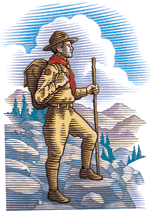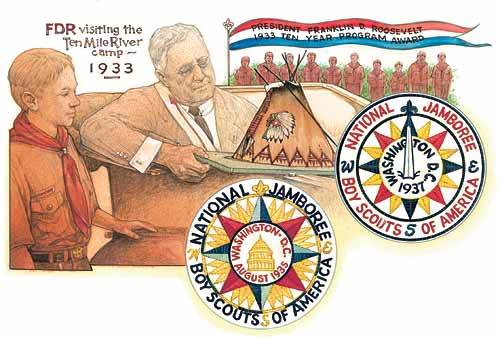![]() March - April 2003
March - April 2003


A Best Friend in the White House
By Thomas P. Campbell
Illustration by Joel Snyder
Franklin D. Roosevelt's presidential endorsement of the first national Scout jamboree continued his personal history of dedicated support for Scouting.

The title of Honorary President of the Boy Scouts of America has been given to every U.S. president since William Howard Taft. Altogether, 17 presidents have now accepted this honor. Among them, none has been a more enthusiastic, longtime, and active Scouting volunteer than Franklin D. Roosevelt.
In 1915, FDR was the young assistant secretary of the Navy when Chief Scout Executive James E. West solicited his support of the five-year-old Boy Scouts of America. West asked FDR to serve as a member of the Special Committee on Nautical Scouting.
In 1921, shortly after agreeing to become more active in New York City Scouting, FDR was disabled by polio, losing the use of his legs. During his effort to regain his health and mobility in the years that followed, his involvement in Scouting grew. His political activities also increased, and during the 1920's he became a prominent national figure.
FDR played a major role in the effort to obtain a permanent camp for New York City Scouts, and in 1927, he was one of a group credited with opening Ten Mile River Scout Camps.
He enjoyed visiting the camp even as governor of New York. In August 1930, during a ceremony at camp, FDR was presented the Silver Buffalo Award, the BSA's highest national honor for service to youth. During another visit three years later, he was inducted into the Order of the Arrow and posed for photographs proudly wearing his OA sash.
Some ways to help
Following his election in 1932 as president, FDR agreed to serve as Honorary President of the BSA. He reaffirmed his "ardent friendship" for Scouting by inviting the BSA National Council to hold a meeting at the White House. At that meeting he asked how he could help Scouting in "a practical fashion."
In response, James West proposed that a national jamboree be held in Washington, D.C., under FDR's "personal auspices or sponsorship." The president agreed and told West "that idea of yours about the Boy Scout meeting in Washington is a good one and pleases me very much..."
Scheduled for the summer of 1935, the first national Scout jamboree was only a few weeks away when an epidemic of polio hit eastern Virginia. Faced with the prospect of more than 25,000 Scouts and leaders arriving in Washington, the commissioners of the District of Columbia, bowing to the wishes of the U.S. Surgeon General and with the consent of the president and the Chief Scout Executive, decided that health and safety required cancellation of the jamboree.
FDR personally informed the public of the news in a national radio broadcast.
When West informed FDR that the BSA had decided to reschedule the jamboree for 1937, the president said he was "delighted."
The broadcast of his annual anniversary message for Scouting in 1936 included an enthusiastic approval of the rescheduled event. Addressing his "fellow Scouts," FDR paid tribute to the ideals of Scouting and then renewed his "invitation for the Boy Scouts to hold a jamboree" in Washington in1937.
"We are going ahead...planning to have a city of tents rise here in the Capital, actually within the shadow of the Washington Monument," he said. "It stirs my imagination, and I am sure that it gives all of you a genuine thrill."
With this great endorsement from the president, the jamboree plans and preparation gained broad support and assistance throughout the government.
Taking FDR's suggestion, West persuaded the trade association for the railroad industry to renew its 1935 commitment to transport Scouts to the jamboree for a fare of one cent per mile. This and other developments were regularly reported to the president, who received jamboree identification card No. 1 along with a detailed program schedule from West.
At the jamboree
On June 30, 1937, the jamboree opened. Scouts were greeted at their campsites with copies of the Jamboree Journal, a photograph of FDR on page one. The president's message of greeting praised Scouting as a great source of training in the virtues of good citizenship.
FDR gave his personal attention to the huge gathering. After taking 12 Eagle Scouts to baseball's annual major-league all-star game, he toured the jamboree site. Accompanied by James West and National Scout Commissioner Dan Beard, he stopped at the Sea Scouts' camp and then visited the Scouts from Duchess County, N.Y., whose construction of a large replica of the Roosevelt family home at Hyde Park, N.Y., attracted his attention.
The president, from his touring car, awarded an Eagle badge, spoke with leaders, examined some handicrafts, and posed for photographs. As his car moved out of the jamboree site, many Scouts swarmed around it, seeking a look at the president.
The jamboree concluded with a "grand national review." A procession of automobiles reviewed a two-mile assembly of Scouts on both sides of Constitution Avenue.
The first national jamboree, a significant event in the BSA's history, was full of risk. A failure of any nature would have been a public relations calamity, especially after the 1935 cancellation. FDR's endorsement and assistance in obtaining federal and city government support was vital to the event's success. Throughout government, officials readily responded to requests from White House staff members and, through them, to requests from West and the BSA staff.
Publicity of the jamboree brought much favorable notice to the BSA. Members of Congress, like Senator Harry S. Truman of Missouri, alerted by their constituents and local newspapers to the visiting Scouts, were pleased to be photographed and quoted in the Jamboree Journal.
Radio editorials matched newspapers with compliments for Scouting.
The 1937 jamboree was probably FDR's last significant assistance to Scouting. As 1938 dawned and war clouds gathered around the world, the president became increasingly occupied with his responsibilities as chief of state. Nevertheless, he had established himself as the greatest friend Scouting ever had in the White House.
An attorney and Scouter, the late Thomas P. Campbell became interested in FDR's involvement with the BSA while doing research at the FDR Presidential Library and Museum at Hyde Park, N.Y.
March-April 2003 Table of Contents
Copyright © 2003 by the Boy Scouts of America. All rights thereunder reserved; anything appearing in Scouting magazine or on its Web site may not be reprinted either wholly or in part without written permission. Because of freedom given authors, opinions may not reflect official concurrence.
| The Boy Scouts of America | http://www.scouting.org |